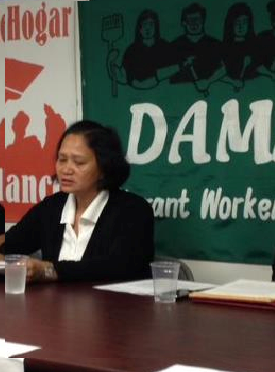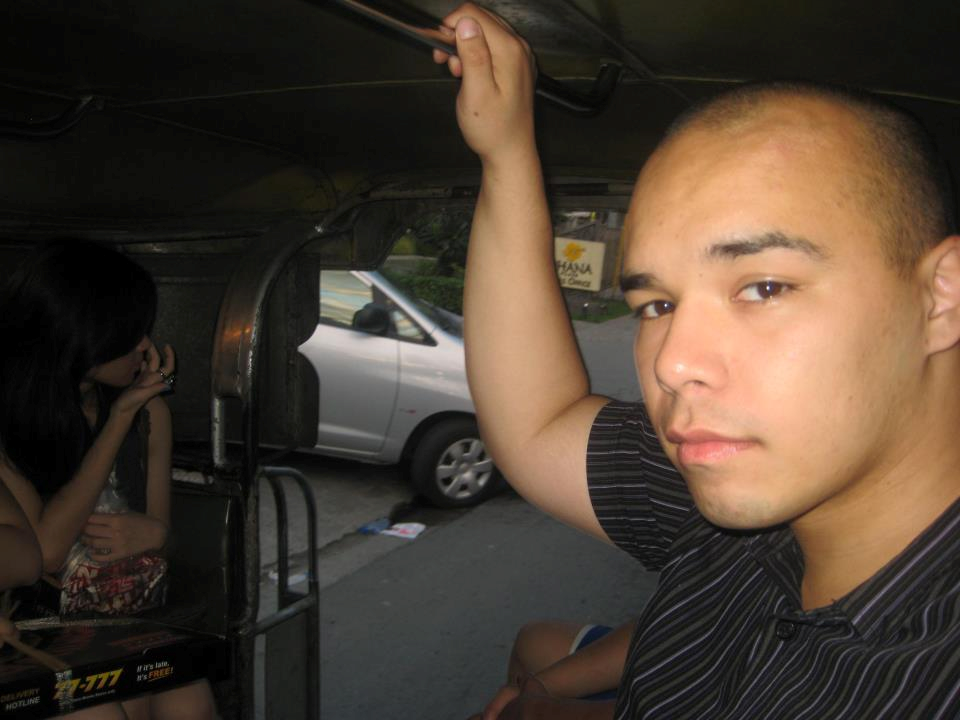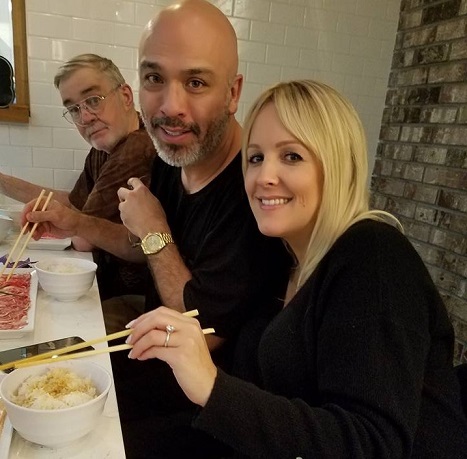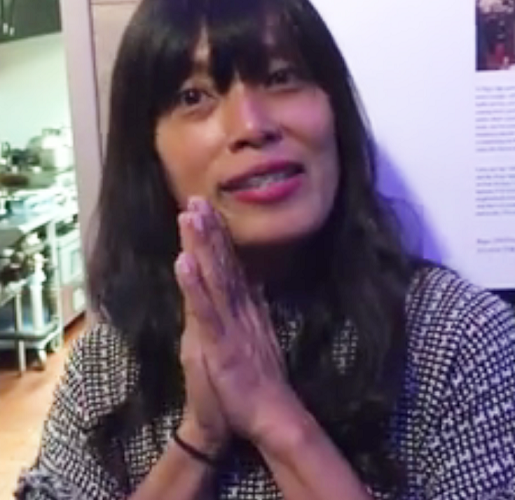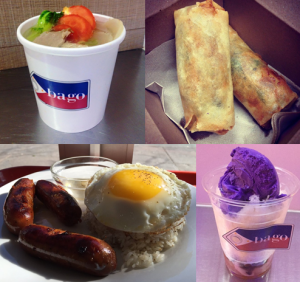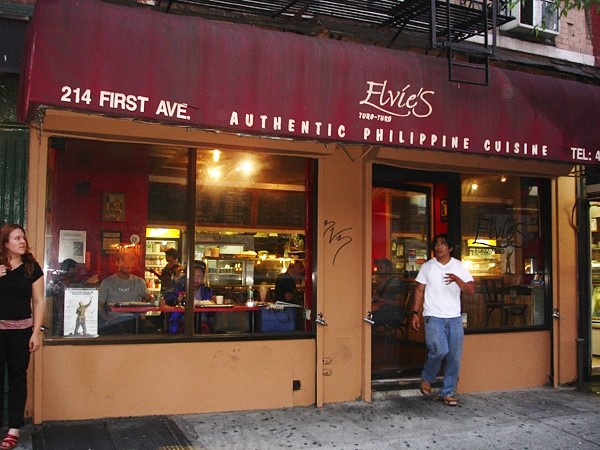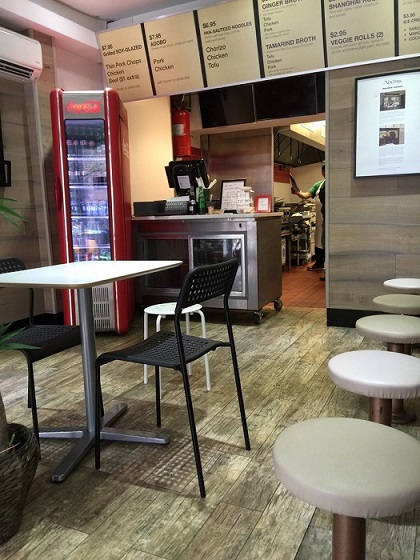From Elvie’s to BAGO: A daughter’s journey to bring mom’s cooking from ‘turo-turo’ to Yelp
By Cristina DC Pastor
This article is being published as a project of the Business Reporting Fellowship of the Center for Community and Ethnic Media at the CUNY Graduate School of Journalism.
“Where’s Elvie?”
Carla Cinco is amused. What her mother’s loyal customers are really asking is: Where’s the turo-turo?
Elvie’s Turo-Turo, the first Filipino restaurant in the East Village, shut its doors in 2009 after nearly 12 years of operation when owner Elvira Cinco retired to the Philippines. One of her daughters tried to revive it and was in business for about two years before deciding to throw in the wash towel.
“We were definitely out by 2012. It was like the end of an era,” Carla Cinco, another daughter, said with a laugh.
She had watched during the years her mother ran Elvie’s. Sometimes Carla was running the cash register, other times she was skewering barbecue. She was taking note of how she would do things differently.
On June 15, Carla, the third of four Cinco children, opened her own eatery across from the old Elvie’s on First Avenue. It’s not just a matter of continuing her mother’s culinary tradition, but wanting to run a restaurant her way.
“I wanted to just finally do it,” she said. “ I was thinking, I would take what I thought was a good idea and then revise what I thought was needed to open up the audience a lot more. Like the all-Tagalog menu. I think it frustrated a lot of non-Filipinos. I really wanted to change that.”
BAGO means ‘new’ in Tagalog. To Carla, it connotes other things, like ‘food on the go’ (bag go) and above all, it means “change.”
BAGO looks nothing like Elvie’s.
To begin with, there is a certain urban sophisticated feel to its all-white interiors, wood flooring, with bar stools in a warm shade of gray, presumably a style carryover from when Carla managed the Madison Avenue showroom of Adrien Linford furnishings.
The menu is in English, and so some Filipinos may not easily get that Icy Tapioca Shake is actually good old-fashioned Halo-Halo.
While pointing to an array of dishes in a glass counter was the hallmark of the old Elvie’s, there is no turo-turo (literally meaning ‘point- point’ in Tagalog) in BAGO. Elvie’s introduced this style of ordering food in Manhattan in early 1990s to cater to mostly Filipino nurses from Beth Israel, Bellevue and nearby hospitals, who wanted their lunch to be steaming hot, quick, and cheap.
“My mom was such a great cook,” said Carla when interviewed by The FilAm. “She was always entertaining at home, and she brought that homey feel to Elvie’s.”
It’s been six years since the departure of Elvie’s, and a lot has changed in the manner food is cooked, ordered, and delivered. Carla wanted to run BAGO to reflect the synchronized efficiency of the digital lifestyle.
The East Village, a neighborhood that inspired the Broadway musical “Rent,” is known for its artists, musicians and students, as well as expat professionals. There is robust diversity in its retail shops as well as its bars and restaurants.
In the early1990s, Elvie’s was the only Filipino restaurant here, a true East Village pioneer. When it closed, the void was quickly filled. That parallel stretch of First and Second avenues from 14th street down to 7th street now has six Filipino restaurants, including BAGO. To New York’s Filipino American food snobs, it is their ‘Little Manila.’
Carla knew she was straying into a crowded field – that includes Jeepney and Maharlika, Ugly Kitchen, Grill 21, and Tito King’s – but went ahead anyway. She partnered with a friend to set up BAGO. Her friend, a “silent partner,” invested, but Carla holds the majority while at the same time running the restaurant’s Operations.
“I put all my money, I borrowed from someone I used to work for as well,” she said. “That was tough. I just kept going tiil I had enough. I wasn’t going to give up.”
Before immersing herself completely in the food business, she worked for Adrien Linford furnishings first for eight years and then as a personal shopper for Bergdorf Goodman for six years.
“I really learned a lot (at Adrien Linford),” she said. “The owners, my ex-bosses, they were perfectionists.”
BAGO emerged as the trendy Elvie’s by becoming visible online and streamlining the menu. Carla chose dishes that are quick to prepare and yet delicious. Her most-sought-afters are the Grilled Soy Glazed Pork Chops (Chicken or Beef) and the ever-popular Adobo with meats stewed in soy sauce and garlicky vinegar.
“I do not have the Dinuguan (pig’s blood with chopped entrails yet, but will roll out Pinakbet (a vegetable dish) soon,” she said. These specialty regional dishes were standard fare at Elvie’s back then.
Carla keeps an eye on the mainstream market and not just the Filipino community, and keeps her price points within reach. Affordable, quality, and quick service, according to her, are the standards that set BAGO apart from the other Filipino restaurants. A dish costs from $6.95 to $7.95. Eight pieces of Shanghai Rolls go for $5.45, while Pan Sauteed Noodles (Pancit), for $6.95, is big enough to share. As noted by the New York Times, everything is “under $10.”
BAGO is a welcome addition to the neighborhood, said Nicole Ponseca, who owns Maharlika and Jeepney.
“I used to walk the streets of the East Village looking for something that reminded me of home. Now, with all of the restaurants, it’s just home,” she said.
Maharlika and Jeepney, as well as Ugly Kitchen, have seen really strong patronage over the years, a favorite among younger FilAms who have a craving for the food of their parents and where the restaurant setting is more like a hip pub than the old-style Filipino dining room with ‘banig’ walls and plastic table cloths. A place where they can proudly bring their American friends. BAGO has the same kind of feel. It is clean and bright, and just like Starbucks, one with a Laptop can linger.
Carla does not stop at the price points. She signed up with two service providers to deliver BAGO’s dishes throughout Manhattan. Her dishes are up on GrubHub, where they become available for online ordering. In something like 15 to 20 minutes, food is ready for pick-up or delivery courtesy of the couriers at Orderhood. She reckoned that about 20 percent of her sales comes from online orders.
“They’re connected to my system,” she explained how Internet ordering works. When someone places an order, she gives herself time to process it. The delivery guy arrives within at least 5 minutes after the food is ready. Once it’s packed and given out for delivery, said Carla, “it’s out of my hands.” Sometimes, she gets hit with a bad review for delayed delivery. Overall, the system is competent and widens her reach all the way to Soho or Rivington and Stanton in Lower Manhattan.
“Back then this (system) didn’t exist,” she noted.
In Elvie’s time, the restaurant business was supplemented by catering parties and participating in street fairs. BAGO caters too, said Carla, but there are now more effective ways of reaching a wider audience.
She recently met with Yelp managers to discuss how BAGO can become more visible on its online platform. An account has been set up complete with photos of mouthwatering dishes, customer feedback, and it welcomes reviews.
“My meeting with Yelp went well,” she said. “We’ll see. Statistics show that the general public pays attention to Yelp. It’s where they first go to see a restaurant’s credibility. It’s sort of your gauge in how well you’re doing and what other improvements you need to do.”
There’s one proud thing BAGO had in common with Elvie’s: A pat on the back from the New York Times.
Within months after it opened, Elvie’s had a nice review at the Times Food Section, which praised its Adobo dish.
“The NYT review came in very quickly for (Elvie’s), and we just went up from there. It put her on the map, it’s like an honor. That was a big deal,” she recalled.
The Times also did a write-up of BAGO, calling it “a modest Filipino restaurant in the East Village where the dishes are cooked to order and brought to your table.”
No doubt, the article has raised awareness, and to some extent sales, said Carla. “We really got noticed.”


